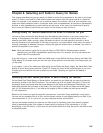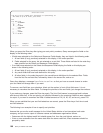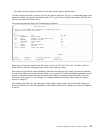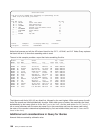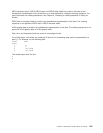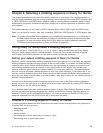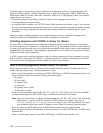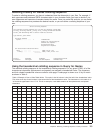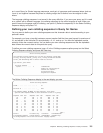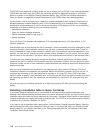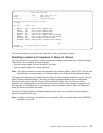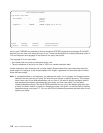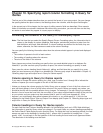
To collate means to place items in proper sequence or to check that items are in proper sequence. For
Query for iSeries purposes, collating sequences apply to SBCS character data in SBCS, DBCS-open, or
DBCS-either fields, not numeric, date, time, timestamp, DBCS-only, or DBCS-graphic fields. The collating
sequences you can use are:
v The collating sequence provided by Query for iSeries for the language of your country.
v A collating sequence that you define.
v A translation table, created by the CRTTBL (Create Table) command, that exists in one of your libraries.
v One of the sort sequences supplied with the system. For each supported language, the system supplies
one table with unique weights for all characters and a second table with shared weights for some
characters.
Unless you select a collating sequence, the standard sequence used for collating is the same as the
numeric sequence of the hexadecimal values used to represent the characters.
Collating sequence and CCSIDs in Query for iSeries
You can define a collating sequence by assigning a sequence number to each character in a displayed
list. After renumbering in increments of 10 starting from 64 (’40’X), the assigned number for each character
is saved in the one-byte table entry at the offset that corresponds to the numeric value of the hexadecimal
representation of the character. The hexadecimal representation can be used later to retrieve the collating
weight for character data comparisons.
A CCSID is saved with a collating sequence so that the collating sequence can be converted for use with
data in a different code page. Conversion of a collating sequence is a matter of rearranging the numbers
in the table so that the appropriate collating weight is found for each character.
How a collating sequence affects Query for iSeries
Several definition steps in Query for iSeries use the selected collating sequence to determine the final
results when your query is run. A collating sequence is used:
v When you join files together by comparing an SBCS, DBCS-open, or DBCS-either character field in one
file to a character field in the other file by using the following tests:
– EQ (equal)
– NE (not equal)
– GT (greater than)
– LT (less than)
– GE (greater than or equal)
– LE (less than or equal)
v When you use comparison tests like EQ, NE, GT, LT, GE, LE, LIKE, NLIKE, LIST, NLIST, and RANGE
to select records based on SBCS, DBCS-open, or DBCS-either character field values
Note: Query for iSeries does not use the collating sequence for EQ, NE, LIST, NLIST, LIKE, and NLIKE
comparisons, or apply it to SBCS characters in DBCS fields and constants, when the Use
collating sequence for all character comparisons option is set to NO (the default for a query
from a release earlier than Version 2 Release 3) on the Specify Processing Options display.
v When you select an SBCS, DBCS-open, or DBCS-either character field for sorting records
v When you define minimum and maximum summary functions for an SBCS DBCS-open, or DBCS-either
character field
v When you define report breaks on an SBCS, DBCS-open, or DBCS-either character field
112 Query for iSeries Use V5R2




